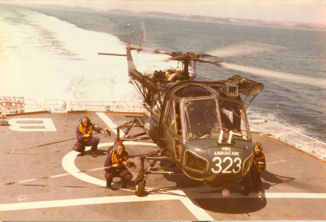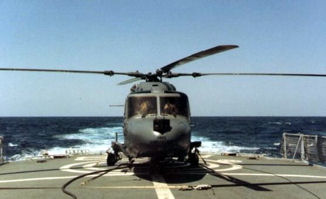Looking after the AMBUSCADE FLIGHT by David Marchant
Westland Wasp HAS 1
Initial training was carried out by 702 Squadron, at Royal Naval Air Station Portland for both air and ground crews. When qualified, personnel were then allocated a front line Flight. The Flight’s parent base was 829 Squadron also based at Portland, where deep servicing was carried out as well as continuation training, and pre embarkation inspections. Flight ground crew usually embarked a day or two before the ship sailed. Much organisation and effort undertaken to ensure that all ground equipment, tools, spares etc was transported by road. Aircraft usually embarked when the ship was at sea or sometimes alongside in harbour: usually at the ships parent base, in the case of Ambuscade Flight – Devonport. Occasionally Portland, rarely Rosyth.
Flying depended on ships programme, and operations – but usually on a regular basis in order to keep the Flight and ship operational. During work-ups and exercises, the ‘Cab’ as it was known to the Flight, was in constant demand, with various role changes incorporated. With only one aircrew and duty flight crew, operational hours were restricted but variable day or night. Weather limitations also affected operations. Even though there was no flying scheduled, routine servicing and maintenance continued, and many long hours were worked.
Prior to flying, preparations commenced with hangar door wound fully open (manually). ‘No Entry - Flying Stations’ signs were placed at any access to the flight deck and a thorough FOD (Foreign Object Damage) inspection done. In the days when smoking was the norm, a broadcast was made throughout the ship reminding the ship’s company that ‘No smoking abaft the main mast’, and similarly with environmental conditions that ‘No gash to be ditched’. The PD150 Dry Powder fire extinguisher was wheeled out and bolted to the deck on the port side, and two fire hoses with foam nozzles reeled out in port and starboard waists. Telephone lines and other voice communications were checked, as well as the various lighting systems, and glide path indicator. Electrical cable and tele-brief laid out on the deck, plus the aircraft tied down link bolted to the shackle in the centre of the flight deck (pre harpoon days). Nylon lashings were laid out along the route to the flight deck and attached to the ring bolts.
The Wasp was pushed out manually, with one member controlling the direction with a steering arm inserted in one of the castoring wheels. Hydraulic wire winches were installed but used very rarely or in extreme weather. Orders and directions for the move were given by the POAM, who had previously checked with the Officer of the Watch on the bridge and that the ship would remain on a steady course – occasionally this was unsteady, and half way through the move a desperate attempt was made to restrain nearly two tons of helicopter sliding across the deck . When on the spot, aircraft lashed down with nylon quick release strops and tie-down link attached. Power cable and tele-brief connected. Oleo restraints removed. Tail and blade unfold commenced and blade cradle removed. Transponder, unfolded. Fuelled up as required. Before flight inspection carried out and signed for. Hangar door lowered to half way to protect contents. Deck-edge nets lowered. Interesting stuff on a moving deck in all weathers – all good for a healthy complexion (except for the exhaust gasses from the funnel and the smell of grease from the galley vent!). The flight brief was carried out on the bridge by the HC, and was attended by the pilot, aircrewman, Captain, OOW, PWO etc. The sea-boat was also prepared and the swimmer of the watch dressed in his dry suit.
After the pilot checked with the SMR, signed for the aircraft and carried out a ‘walk around’ with one of the engineers, he and the aircrewman strapped in. Four members of the flight crouched by each lashing point prior to start up. When the FDO had received clearance from the bridge, he gave the necessary signals. Permission to launch was given, after consideration of ships course and wind limitations. Green light on - lashings removed at the double and displayed to the pilot. Pilot releases deck link and take off - normally leaving to starboard.
The Wasp was immediately recognisable with its long legs with four wheeled undercarriage, large cabin and uncovered engine - as well as its unmistakable sound. The wheels were set for ship operations to enable it to swivel into wind if required, and connected to the deck by a simple release link. The rotors also had negative pitch facility in order to assist with it sticking to the deck on landing until it was secured by lashings. As with all aircraft range and payload are interchangeable, and the Wasp with two crew had a typical range of nearly 200 miles or about 2 hours. Its chief operational task was to carry two anti-submarine torpedoes. The Wasp had no sensors: sonar, radar etc and relied almost entirely on the ship or other suitable units for its operations. Due to the range of the torpedoes search pattern, it required great accuracy on the part of the helicopter controller, and the pilot to make a successful attack. It was in fact a simple weapons platform, created to combat the advance in speed and performance of the submarine, and substantially enabled the delivery of a weapon quickly and to a greater range than a surface ship was capable. For attacking surface craft the Wasp was armed with two French-built A.S.12 wire guided missiles. The aircrewman aimed the missiles using a periscope sight mounted above him in the cabin roof, and depending on his skill could hit a target up to 6500 metres away.
The Type 21 was designed from the outset to host the Lynx. Therefore the facilities in terms of space in the hangar and flight deck could be classed as palatial, particularly when compared with the Tribal class frigate. The hangar was equipped with all the facilities for maintenance and storage, including spare engine, rotor-blades etc. Two offices were used – the lower one as the SMR’s domain and the upper one for the Flight crew and included many technical documents, other spare parts and most importantly the tea-boat! Located at hangar level was the weapon magazines.
Recovery to the ship was made under instructions from the HC – normally visually by the pilot, but special procedures using a radar guided Ship Controlled Approach method was made in unsuitable weather. When the weather was extremely marginal this was supplemented by a Poor Weather Approach procedure, whereby floating flares were dropped into the ships wake as an aid to its position. After landing the Wasp would take a rotors running refuel and/or re-arm for a subsequent sortie, or if not required - shut-down and AF (after flight) checks carried out, followed by a fresh water wash and a spray and wipe down with DW40 in order to combat salt corrosion. Stowing in the hangar was the reverse procedure, and the helicopter chained down to the deck. The time was then spent with any required maintenance.
The Wasp was a first generation small-ship helicopter. It was simple, reliable, easy to fly and maintain, and carried out its role nobly. It was a true Cold War warrior – scourge of the Red Fleet.
Westland Wasp HAS 1 XT778
Built at Hayes, Middlesex to Specification HAS.216D&P, to contract KK/N/93/CB25(a), Construction Number F9660; 12/05/1966 - First flight, from Yeovil; 06/06/1966 - Delivered to RNAY Fleetlands; 30/06/1966 - To Aeroplane & Armament Experimental Establishment, Boscombe Down; 18/07/1966 - Into storage at RNAY Fleetlands; 25/09/1972 - RNAY Wroughton; RNAS Lee on Solent; HMS Vernon; 22/02/1973 - RNAS Yeovilton; 05/07/1973 - RNAY Wroughton; 01/10/1975 - 829 NAS HQ Flight, RNAS Portland; 13/11/1975 - Bacchante Flight, 829 NAS; 829 NAS HQ Flight; 28/01/1976 - Ambuscade Flight coded 323; 20/03/1980 - RNAY Wroughton; 19/01/1983 - 829 NAS HQ Flight; 03/05/1983 - Leander Flight; 06/05/1983 - 829 NAS HQ Flight; 21/06/1983 - Naiad Flight; 14/07/1983 - 829 NAS HQ Flight; Tartar Flight; 21/07/1983 - 829 NAS HQ Flight; 23/03/1988 - Achilles Flight coded 430; Aircraft retired; 23/03/1988 - To Ground Reserve at Air Electrical School (AES), RNAS Lee on Solent as A2722 with engine E4783; 10/1991 - With 760 NAS at AES; By now with School of Petroleum, Royal Logistic Corps at West Moors, Dorset; Returned to RNAS Portland and refurbished prior to being placed on gate guard duties; 15/02/1999 - Taken by road to RNAS Yeovilton to join Fleet Air Arm Museum – currently in the Cobham Hall reserve collection.
TECHNICAL DETAILS
Role - Anti submarine and surface vessel helicopter; Manufacturers - Westland Helicopters Ltd; Power plant - One Rolls Royce Nimbus 103 or 104 - 783 kW shp; Rotor diameter - 32ft 3in; Length - 40ft 4in; Height - 8ft 10in; Weight – 3452lb empty, 5,500lb max loaded; Max speed - 138mph at sea level; Range -315 miles; Crew: one pilot, one aircrewman. Capacity: 3 passengers on rear seat, or one stretcher.
Armament –
Mk 44 torpedoes
Mk 46 torpedoes
Mk 11 depth charges
Smoke, flares
or combinations of above.
2 x AS12 air to surface missile
WE177 Nuclear Depth bomb
Light Machine Gun
Roles:
MATCH (Manned Torpedo-Carrying Helicopter), Air to Surface attack, surface search, gunnery spotting, SAR (Search and Rescue), CASEVAC (Casualty Evacuation), photography, VERTREP (Vertical Replenishment – stores transfer).
Winch on starboard door and SACRU (Semi-Automatic Cargo Release Unit) mounted underside of fuselage.
Flight Personnel:
Flight Commander – Lt RN - Pilot
Aircrewman – LACMN / POACMN (Missile Aimer)
SMR (Senior Maintenance Rating) – CPO Artificer/Amechn
CPO/PO (electrical/weapons trade)
PO – Air Mechanic (airframes and engines trade)
LAM / N A M – Air Mechanic (airframes and engines trade)
LEM(A) L,R or AW (electrical/radio/weapons trade)
NA(AH) and/or 2 x Junior Ratings from ship’s company
Flight Deck Officer – secondary duty of trained officer: MAA, Lt Stores, Education officer
Helicopter Controller - normally qualified Leading Seaman RP or PO RP
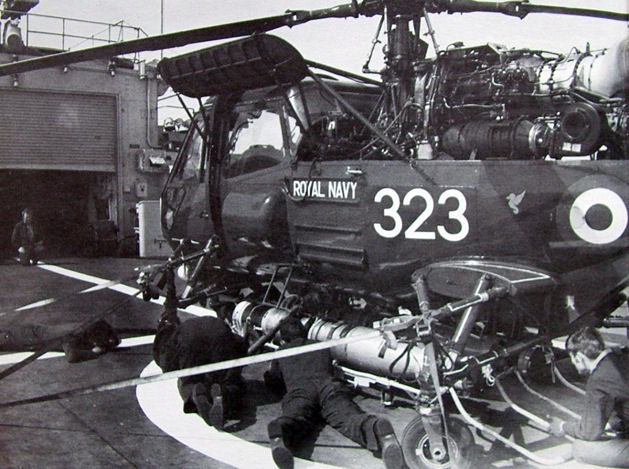
Loading torpedoes on the Wasp
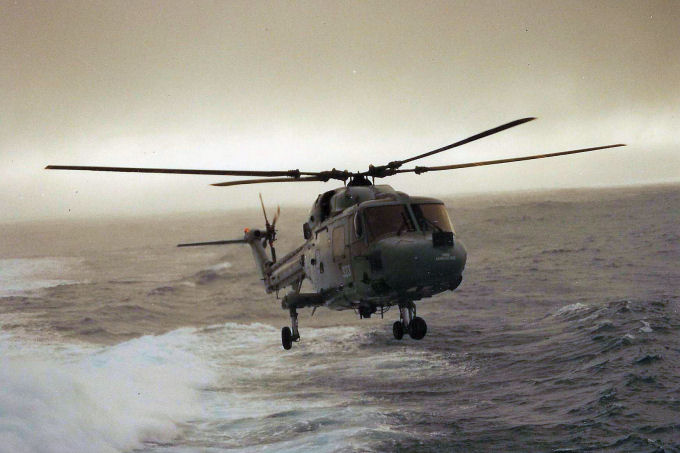
1983
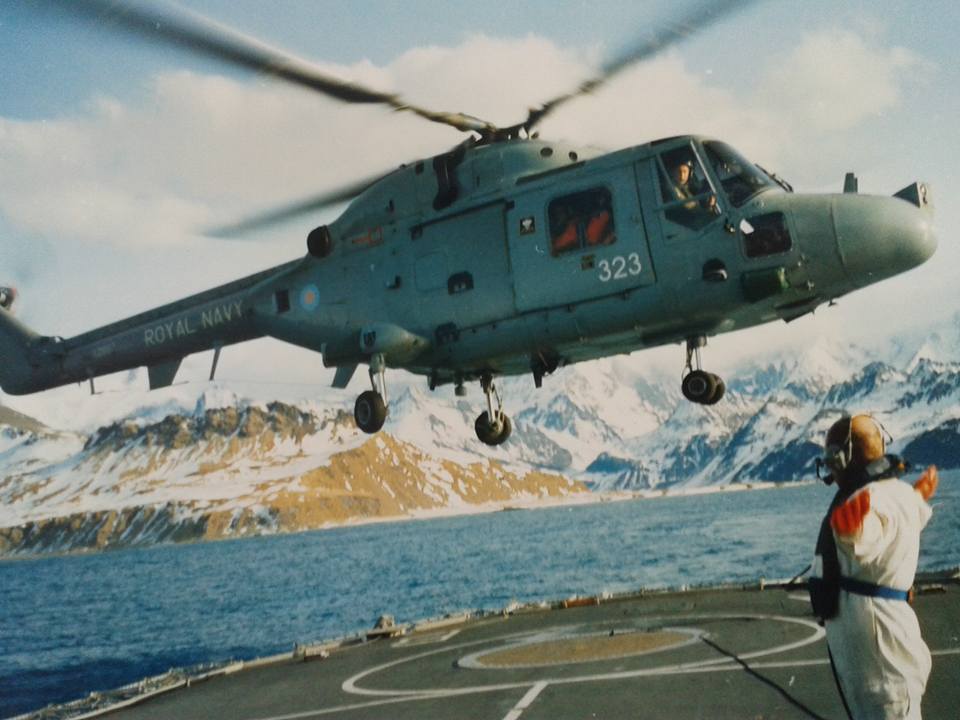
South Atlantic 1992
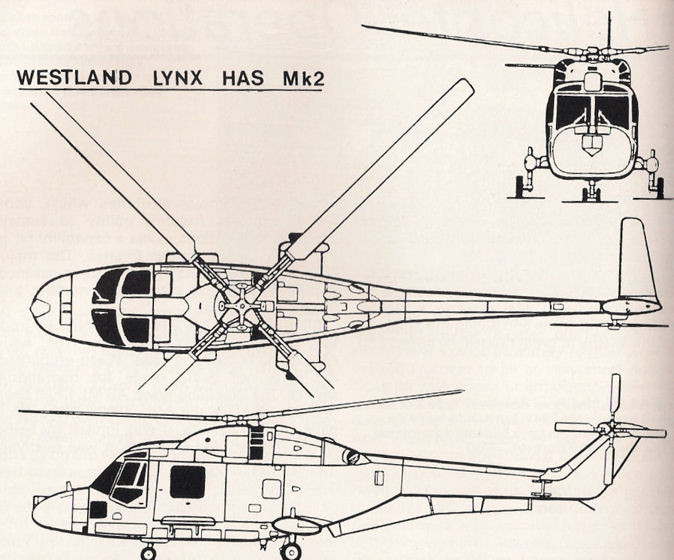
TOP

